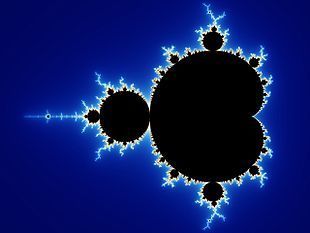The harder we search, the more patterns we find
Have you ever caught yourself staring at a white noise screen, or listening to static and seen or heard a signal? It's not a hallucination but a byproduct of an incredibly powerful differencing engine in action. We come across false alarms often in nature, but when disconnected from rational causation these blips are discarded. A coincidence of random signals is welcome input to the seemingly inexhaustible supply of our mind's processing ability. Sit quiet and still for some time staring at a relatively blank or static surface and you will catch your mind grasping for spatial correlations. The threshold for meaningful patterns drops in a static environment.
Patterns within Patterns
It's only proper that I balance my fascination with self replicating viral patterns for startups with a well known pattern from mathematics.
A fractal is "a rough or fragmented geometric shape that can be split into parts, each of which is (at least approximately) a reduced-size copy of the whole," a property called self-similarity.
Fractals have long been a mathematical and visual anomaly that has captured my interest and imagination. The simplicity of a similar shape regardless of scale, conceals the beauty of a balanced series expansion. The identity of a fractal is cleary independent of the observers distance. When designing software I seek and value logical abstractions that perform equally well at any resolution or scale.
The most popular fractal equation may be the Mandelbrot set:
When computed and graphed on the complex plane the Mandelbrot set is seen to have an elaborate boundary which does not simplify at any given magnification. This qualifies the boundary as a fractal.
The Mandelbrot set has become popular outside mathematics both for its aesthetic appeal and for being a complicated structure arising from a simple definition, and is one of the most well-known examples of mathematical visualization. Benoît Mandelbrot and others worked hard to communicate this area of mathematics to the public.
The replicating pattern arises from the expansion of a complex series which exhibits identical spatial frequencies at any scale. The mathematic description from wikipedia:
In mathematics the Mandelbrot set, named after Benoît Mandelbrot, is a set of points in the complex plane, the boundary of which forms a fractal. Mathematically the Mandelbrot set can be defined as the set of complex values of c for which the orbit of 0 under iteration of the complex quadratic polynomial zn+1 = zn2 + c remains bounded.[1] That is, a complex number, c, is in the Mandelbrot set if, when starting with z0 = 0 and applying the iteration repeatedly, the absolute value of zn never exceeds a certain number (that number depends on c) however large n gets.
For example, letting c = 1 gives the sequence 0, 1, 2, 5, 26,…, which tends to infinity. As this sequence is unbounded, 1 is not an element of the Mandelbrot set.
On the other hand, c = i (where i is defined as i² = -1) gives the sequence 0, i, (−1 + i), −i, (−1 + i), −i…, which is bounded and so i belongs to the Mandelbrot set.
Potential Applications of Scale Invariant Patterns
What other patterns hold their identity independent of observer distance? How best can we leverage our understanding of infinite resolution patterns to aid in modern technical problems like:
- databases that exhibit identical performance characteristics at any scale
- user identity that respects privacy on any service or cross services as well as identity convergence (multiple ids)*
- information identity and ownership both at the micro and global levels
- fair distribution of earned value for collaboration independent of scale
notes:
*= Various IDs exhibit the same pattern independent of observer range (my personal email address, blog, or company email can be differentiated by range/scale by any service using a fractal ID standard.

